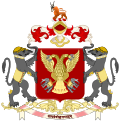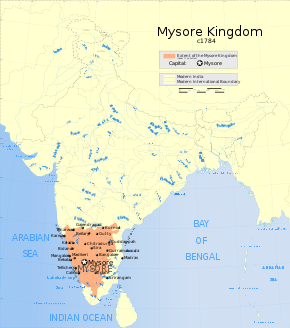Maisúrské království
| Maisúrské království (sultanát) ಮೈಸೂರು ಸಂಸ್ಥಾನ
| |||||||||
| Hymna: ಕಾಯೋ ಶ್ರೀ ಗೌರಿ (Kayou Sri Gowri) | |||||||||
geografie
| |||||||||
rozloha: | 205 000 km² | ||||||||
| obyvatelstvo | |||||||||
| státní útvar | |||||||||
| státní útvary a území | |||||||||
| |||||||||
Maisúrské království (kannadsky ಮೈಸೂರು ಸಾಮ್ರಾಜ್ಯ) byl státní útvar v jižní Indii založený pravděpodobně roku 1399 v oblasti Maisúru v dnešní Karnátace. Pro krátké historické období vlády muslimských panovníků, kteří upřednostňovali islámské náboženství a zavedli muslimskou formu vládnutí jako sultánové, se užívá názvu Maisúrský sultanát.
Historie
Království, kterému vládla dynastie Odejárů, bylo nejdříve vazalem Vidžajanagaru. S úpadkem Vidžajanagaru (okolo 1565) získalo Maisúrské království nezávislost. V 16. století nastala územní expanze Maisúrského království, jehož součástí se staly rozsáhlé oblasti dnešní jižní Karnátaky a části Tamilnádu.
Vrcholu království dosáhlo v 18. století. V době britské koloniální nadvlády se Maisúrské království stalo jedním z knížecích států, zánik království nastal v roce 1947 se vznikem Indické republiky.
Symbolika
- vlajka království (sultanátu)
vlajka muslimských sultánů z období 18. století
Reference
V tomto článku byl použit překlad textu z článku Kingdom of Mysore na anglické Wikipedii.
Externí odkazy
 Obrázky, zvuky či videa k tématu Maisúrské království na Wikimedia Commons
Obrázky, zvuky či videa k tématu Maisúrské království na Wikimedia Commons
Média použitá na této stránce
My own crown and own star, PD Union by Zscout
Autor: Rustyshackelford, Licence: CC BY-SA 4.0
This is the royal coat of arms of the Kingdom of Mysore. It was originally designed in the late 1800s by Robert Taylor, a graduate in Master of Arts from the University of Cambridge and an employee in the Bengal Civil Service in British India. This is an initial vector version of the coat and contains numerous errors. Needs further revision.
Atop, in the crest, is a lion holding in its mouth the severed head of a satanic goat, symbolising the killing of Mahisha by Goddess Chamundi, the very essence of the Wadiyar dynasty, the city of Mysore, and the Kingdom of Mysore.
In the shield is the Gandaberunda, a two-headed mythical eagle, one head symbolising justice, the other freedom. It is supposed to betoken the idea that when one head falls asleep, the other is awake, thus fulfilling their duty of eternal freedom and justice. It holds in each of its hands and beaks an elephant. The elephant is a symbol of Goddess Lakshmi, the deity of wealth.
The shield is upheld by Sharabha, a mythical elephant-headed lion symbolising strength and valour.
The motto, सत्यमेवोद्धराम्यहम् in Sanskrit means "truth alone I shall uphold", a family motto of the Maharajas of Mysore.
A majority of this regal insignia is borrowed by the emblem of the Government of Karnataka, the kingdom's successor, as by that of the University of Mysore.Autor:
This Image was created by User:PlaneMad.
|
Map showing the extent of the Mysore Kingdom under Tipu Sultan including the Keladi Kingdom.
Autor: Thatcatdomino, Licence: CC BY-SA 4.0
Flag of Mysore Hyder Ali & Tipu Sultan
Flag of Vijayanagara Empire










